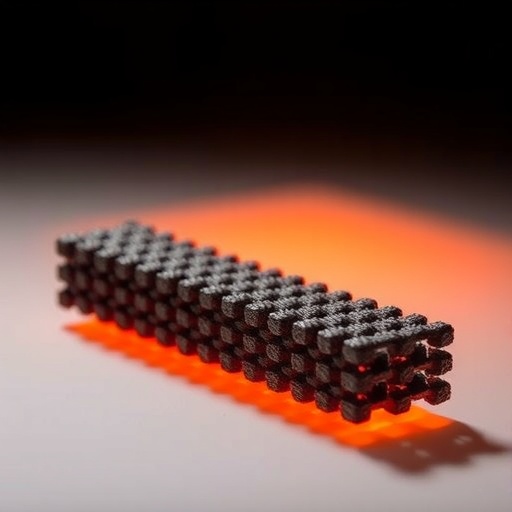Electrocatalysis has emerged as a pivotal technology within the realm of energy conversion and storage, facilitating the transformation of chemical energy into electrical energy through various mechanisms. The efficiency of these processes greatly hinges on the quality and characteristics of the electrocatalysts employed. In this pursuit of enhancing electrocatalytic activity, porous carbon fibers have garnered significant attention due to their unique structural properties and high conductivity. In a groundbreaking study by Bian, Qiao, and Ding, the innovative approaches toward modifying these porous carbon fibers for improved electrocatalytic reactions are meticulously explored.
At the core of this study is the fundamental understanding that the structure of carbon materials plays a crucial role in determining their performance in electrocatalytic reactions. The authors provide a comprehensive overview of existing modification techniques, emphasizing how variations in pore size, surface area, and chemical functionalization can dramatically influence the reactivity and selectivity of carbon-based electrocatalysts. These alterations not only enhance the surface area available for reaction but also help in tailoring the electronic properties necessary for optimal catalytic performance.
One of the focal points in the study is the utilization of various synthesis methods to create porous structures in carbon fibers. The authors delve into techniques such as electrospinning, chemical vapor deposition, and templating methods, each offering unique advantages in generating fibrous carbon materials with specific surface morphologies. The diverse range of techniques available allows researchers to fine-tune the properties of carbon fibers, paving the way for enhanced performance in electrocatalytic settings.
The modification of porous carbon fibers does not stop at mere structural changes; chemical functionalization is another critical aspect addressed in the research. The incorporation of heteroatoms, such as nitrogen, sulfur, and phosphorus, into the carbon framework is highlighted as a mechanism to create active sites that facilitate faster electron and ion transfer processes. These doped porous carbon materials have shown promise in various electrocatalytic applications, including hydrogen evolution, oxygen reduction, and CO2 reduction reactions.
The authors also explore the synergistic effects that arise when combining different modification strategies. By integrating structural modifications with chemical doping, researchers can achieve remarkable improvements in both activity and stability of the electrocatalysts. This multi-faceted approach appears not only to promote the desired catalytic reactions but also to enhance the durability of the materials, addressing one of the significant challenges in the field—material degradation over time.
Furthermore, Bian and colleagues shed light on the characterization methodologies essential for evaluating the performance of modified porous carbon fibers. Techniques such as scanning electron microscopy (SEM), transmission electron microscopy (TEM), and X-ray photoelectron spectroscopy (XPS) play a crucial role in elucidating the structure-property relationships inherent in these materials. By employing these advanced characterization techniques, researchers can obtain insight into how specific modifications impact the overall electrocatalytic efficiency.
The implications of these advances in porous carbon fibers extend beyond mere laboratory settings. As the demand for renewable energy sources continues to escalate, the development of efficient electrocatalysts is more urgent than ever. The insights gained from this study not only contribute to the scientific discourse but also provide a roadmap for industrial applications, potentially leading to cost-effective and scalable energy solutions.
As the study culminates, it underscores the importance of continued research into the modification of carbon-based materials. The versatility of porous carbon fibers stands as a testament to their potential in revolutionizing electrocatalytic applications. The ongoing developments in this area promise to unlock new pathways for energy conversion and storage technologies, addressing the pressing challenges posed by contemporary energy needs.
In conclusion, the research conducted by Bian, Qiao, and Ding serves as a cornerstone in the evolving narrative of electrocatalysis. Through their innovative exploration of porous carbon fibers, they offer not only a glimpse into the future of electrocatalytic processes but also a call to action for scientists and engineers alike. The ongoing dialogue surrounding carbon modifications holds great promise for advancing the field, heralding a new era of clean and sustainable energy technologies.
With the advancements discussed in this research, one cannot overlook the intertwined relationship between material science and energy technology. As knowledge expands, the potential to harness these insights into practical applications becomes more tangible. The synergy between fundamental research and applied sciences is critical for bridging the gap between laboratory discoveries and real-world energy solutions.
As we look ahead, the unique properties of porous carbon fibers will undoubtedly serve as a catalyst for further investigation and innovation in electrocatalytic systems. The collective efforts of researchers in this domain will shape the future of energy technologies, making significant strides towards addressing global energy challenges while fostering sustainable practices.
In summary, the study conducted by Bian and colleagues underscores a transformative approach towards enhancing the electrocatalytic efficiency of porous carbon fibers. Their findings reflect a broader trend in materials science, emphasizing the necessity of holistic approaches that combine structural modification, chemical functionalization, and thorough characterization. As the landscape of energy technologies continues to evolve, the insights derived from this research will undoubtedly play a vital role in guiding future explorations and applications in the field of electrocatalysis.
Subject of Research: Modification of porous carbon fibers for electrocatalytic reactions.
Article Title: Advances in modifying porous carbon fibers for boosting electrocatalytic reactions.
Article References:
Bian, K., Qiao, Z. & Ding, C. Advances in modifying porous carbon fibers for boosting electrocatalytic reactions.
Ionics (2025). https://doi.org/10.1007/s11581-025-06722-2
Image Credits: AI Generated
DOI: https://doi.org/10.1007/s11581-025-06722-2
Keywords: Electrocatalysis, porous carbon fibers, modification techniques, chemical functionalization, renewable energy.
Tags: chemical functionalization of carbon catalystscomprehensive overview of modification techniqueselectrocatalysis in energy storageenhancing electrocatalytic activityhigh conductivity in porous carboninnovative approaches in electrocatalysismodified porous carbon fibers for reactionsoptimizing electrocatalyst performancestructural properties of carbon materialssynthesis methods for carbon fiberstailoring electronic properties in catalystsvariations in pore size and surface area





